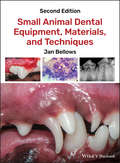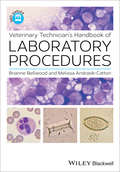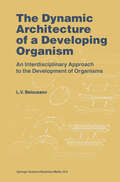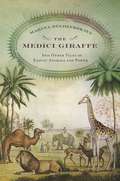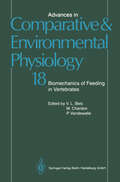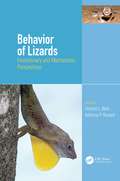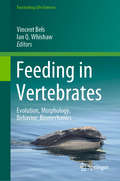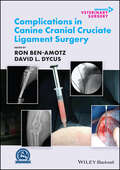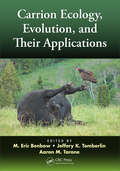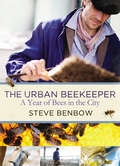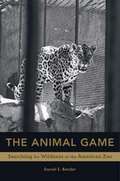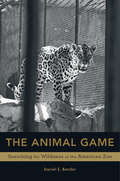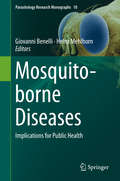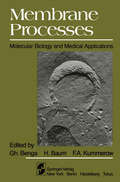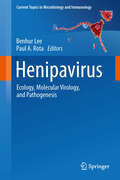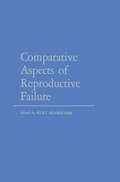- Table View
- List View
Small Animal Dental Equipment, Materials, and Techniques: A Primer
by Jan BellowsThe second edition of Small Animal Dental Equipment, Materials, and Techniques has been revised and updated to reflect the latest developments in veterinary dental practice. Provides a comprehensive resource for integrating dental services into veterinary practice Offers valuable advice on selecting dental equipment and materials Presents clear descriptions for a range of dental terms and techniques Includes a wealth of new images Highlights dental information applicable to general practice
Small Animal Dental Equipment, Materials, and Techniques
by Jan BellowsThe second edition of Small Animal Dental Equipment, Materials, and Techniques has been revised and updated to reflect the latest developments in veterinary dental practice. Provides a comprehensive resource for integrating dental services into veterinary practice Offers valuable advice on selecting dental equipment and materials Presents clear descriptions for a range of dental terms and techniques Includes a wealth of new images Highlights dental information applicable to general practice
Veterinary Technician's Handbook of Laboratory Procedures
by Brianne Bellwood Melissa Andrasik-CattonVeterinary Technician's Handbook of Laboratory Procedures is a quick-reference guide to conducting common laboratory tests. Carefully designed for fast access, the book covers common laboratory equipment, quality control, blood analysis, urinalysis, parasitology, and cytology. Important information is clearly and succinctly outlined for frequently used lab tests, providing step-by-step procedures, discussions of common errors, and tips and tricks, with more than 200 color images to aid in identification. A companion website offers case studies, crossword puzzles, figures from the book in PowerPoint, and additional figures not found in the printed book at www.wiley.com/go/bellwoodhandbook. Veterinary Technician's Handbook of Laboratory Procedures is an invaluable tool for finding essential information on performing a wide range of laboratory tests.
Veterinary Technician's Handbook of Laboratory Procedures
by Brianne Bellwood Melissa Andrasik-CattonVeterinary Technician's Handbook of Laboratory Procedures is a quick-reference guide to conducting common laboratory tests. Carefully designed for fast access, the book covers common laboratory equipment, quality control, blood analysis, urinalysis, parasitology, and cytology. Important information is clearly and succinctly outlined for frequently used lab tests, providing step-by-step procedures, discussions of common errors, and tips and tricks, with more than 200 color images to aid in identification. A companion website offers case studies, crossword puzzles, figures from the book in PowerPoint, and additional figures not found in the printed book at www.wiley.com/go/bellwoodhandbook. Veterinary Technician's Handbook of Laboratory Procedures is an invaluable tool for finding essential information on performing a wide range of laboratory tests.
The Dynamic Architecture of a Developing Organism: An Interdisciplinary Approach to the Development of Organisms
by L.V. BeloussovFor anybody capable of an emotional response to it, any view of a developing organism should give birth to a feeling of amazement and even admiration, whether this development is seen directly, or in the form of a time lapse film, or even if mentally reconstructed from a series of static images. We ask ourselves how such seemingly primitive eggs or pieces of tissue, without any obvious intervention from outside, so regularly transform themselves into precisely constructed adult organisms. If we try to formulate what amazes us most of all about development, the answer will probably be that it is the internal capacity of developing organisms themselves to create new structures. How, then, can we satisfy our amazement in ways that are more or less reasonable, as well as scientifically valuable? This depends, first of all, on what position we choose to regard embryonic development as occupying among other structure creating processes, even including human activities. On the one hand, one might regard the development of organisms as a highly specialized class of processes, unique to themselves and alien to the general laws of nature, or at least not derivable from them and more akin to the deliberate acts of our own human behaviour. In that case our task would become reduced to a search for some specific 'instructions' for each next member of such a class. Whether in an overt or hidden form, some such ideology seems to dominate in present day developmental biology.
The Medici Giraffe: And Other Tales of Exotic Animals and Power
by Marina BelozerskayaA fascinating exploration, spanning two thousand years, of the central role exotic animals have played in war, diplomacy, and the pomp of rulers and luminaries.
Biomechanics of Feeding in Vertebrates (Advances in Comparative and Environmental Physiology #18)
by V. L. Bels P. Aerts M. Chardon P. Vandewalle H. Berkhoudt A. W. Crompton F. De Vree P. Dullemeijer J. P. Ewert T. H. Frazzetta C. Gans S. W. Herring A. Huysseune K. V. Kardong G. V. Lauder S. M. Reilly E. Schürg-Pfeiffer W. W. Schwippert D. N. Stern J.C. Vanden Berge W. Verraes A. Weerasuriya W. A. Weijs C. B. Wood G. A. ZweersAlthough feeding is not yet been thoroughly studied in many vertebrates taxa, and different conceptual and methodological approaches of the concerned scientists make a synthesis difficult, the aim of the editors is to provide a comprehensive overview of the feeding design in aquatic and terrestrial vertebrates with a detailed description of its functional properties. The book emphasizes the constant interaction between function and form, behaviour and morphology in the course of evolution of the feeding apparatus and way of feeding both complementary and basically related to survival interspecific competition, adaptation to environmental changes and adaptive radiations. Special stress is drawn onquantification of the observational and experimental data on the morphology and biomechanics of the feeding design and its element jaws, teeth, hyoidean apparatus, tongue, in order to allow present and further comparisons in an evolutionary perspective.
Behavior of Lizards: Evolutionary and Mechanistic Perspectives
by Vincent L. Bels Anthony P. RussellKey features: Presents a contemporary snapshot of the mechanisms underlying the evolution and adaptation of behavior Explores how genetics, epigenetics, development, and environment shape behavior Discusses a broad range of behavioral repertoires and responses, including those related to thermoregulatory, foraging, predatory, displaying, social and escape strategies. Examines physiological and sensory mechanisms Covers the effects of various aspects of global change on behavior, with chapters that focus on the impacts of climate change on hydroregulatory behavior and behavioral responses to the effects of habitat alteration resulting from human-mediated change and colonization by invasive species. Lizards serve as focal organisms for many of biological questions related to evolution, ecology, physiology, and morphology. They are studied at multiple spatial and temporal scales, from the individual to the community level. This book, authored by expert contributors from around the world, explores behaviors underlying the evolution and adaptation of these organisms. It covers conceptual, empirical, and methodological approaches to the understanding of the role that natural and sexual selection play in molding the behavioral traits of lizards. This thorough, illustrated reference should stimulate discussion of the conceptual and methodological approaches for studying the behavioral traits of these fascinating and highly diverse vertebrates.
Behavior of Lizards: Evolutionary and Mechanistic Perspectives
by Vincent Bels Anthony RussellKey features: Presents a contemporary snapshot of the mechanisms underlying the evolution and adaptation of behavior Explores how genetics, epigenetics, development, and environment shape behavior Discusses a broad range of behavioral repertoires and responses, including those related to thermoregulatory, foraging, predatory, displaying, social and escape strategies. Examines physiological and sensory mechanisms Covers the effects of various aspects of global change on behavior, with chapters that focus on the impacts of climate change on hydroregulatory behavior and behavioral responses to the effects of habitat alteration resulting from human-mediated change and colonization by invasive species. Lizards serve as focal organisms for many of biological questions related to evolution, ecology, physiology, and morphology. They are studied at multiple spatial and temporal scales, from the individual to the community level. This book, authored by expert contributors from around the world, explores behaviors underlying the evolution and adaptation of these organisms. It covers conceptual, empirical, and methodological approaches to the understanding of the role that natural and sexual selection play in molding the behavioral traits of lizards. This thorough, illustrated reference should stimulate discussion of the conceptual and methodological approaches for studying the behavioral traits of these fascinating and highly diverse vertebrates.
Feeding in Vertebrates: Evolution, Morphology, Behavior, Biomechanics (Fascinating Life Sciences)
by Vincent Bels Ian Q. WhishawThis book provides students and researchers with reviews of biological questions related to the evolution of feeding by vertebrates in aquatic and terrestrial environments. Based on recent technical developments and novel conceptual approaches, the book covers functional questions on trophic behavior in nearly all vertebrate groups including jawless fishes. The book describes mechanisms and theories for understanding the relationships between feeding structure and feeding behavior. Finally, the book demonstrates the importance of adopting an integrative approach to the trophic system in order to understand evolutionary mechanisms across the biodiversity of vertebrates.
Food, Science and Society: Exploring the Gap Between Expert Advice and Individual Behaviour (Gesunde Ernährung Healthy Nutrition)
by P. S. Belton T. Belton T. Beta D. Burke L. Frewer A. Murcott J. Reilly G. M. SeddonThere is widespread concern amongst consumers about the safety and acceptability of food, and there are clearly communication gaps between consumers, many food professionals and food industry. This book offers accounts of the two-way nature of this difficult communication process and steps that can be made to bridge these communication gaps in a variety of social and cultural environments. Individual chapters of the book analyze the roles of science, culture, and risk perception, and of mass media and attitudes towards eating. An additional section describes the interface between scientists and lay people with regard to policy-making and agricultural practice.
Complications in Canine Cranial Cruciate Ligament Surgery (AVS Advances in Veterinary Surgery)
by Ron Ben-Amotz David L. DycusFilling a gap in the current literature, Complications in Canine Cranial Cruciate Ligament Surgery provides revision strategies for correcting the complications associated with surgical repair techniques for cranial cruciate ligament rupture, one of the most common causes of a hind limb lameness in dogs. Presenting step-by-step instructions for numerous surgical correction techniques, this practical guide covers articular, extra-articular and osteotomy repair techniques as well as non-surgical management, physical rehabilitation, clinical decision making, and more. The book begins with an overview of cranial cruciate ligament tear, diagnosis, and treatment goals, followed by a discussion of methods for minimizing surgical site infection and complications. Subsequent chapters describe the potential complications of a particular technique and explain how to identify, evaluate, and correct the complication. Throughout the book, hundreds of high-quality clinical photographs show the appearance of complications and demonstrate each step of the corrective procedure. This authoritative guide: Provides step-by-step techniques for surgical corrections of common complications Emphasizes surgical decision making and specific strategies for surgical correction Contains revision strategies for identification of intra-operative complications Covers evaluation and identification of post-operative complications Features more than 400 photographs and clinical images Part of the state-of-the-art Advances in Veterinary Surgery series, Complications in Canine Cranial Cruciate Ligament Surgery is an invaluable resource for surgical residents, veterinary surgeons, and general practice veterinarians alike.
Complications in Canine Cranial Cruciate Ligament Surgery (AVS Advances in Veterinary Surgery)
by Ron Ben-Amotz David L. DycusFilling a gap in the current literature, Complications in Canine Cranial Cruciate Ligament Surgery provides revision strategies for correcting the complications associated with surgical repair techniques for cranial cruciate ligament rupture, one of the most common causes of a hind limb lameness in dogs. Presenting step-by-step instructions for numerous surgical correction techniques, this practical guide covers articular, extra-articular and osteotomy repair techniques as well as non-surgical management, physical rehabilitation, clinical decision making, and more. The book begins with an overview of cranial cruciate ligament tear, diagnosis, and treatment goals, followed by a discussion of methods for minimizing surgical site infection and complications. Subsequent chapters describe the potential complications of a particular technique and explain how to identify, evaluate, and correct the complication. Throughout the book, hundreds of high-quality clinical photographs show the appearance of complications and demonstrate each step of the corrective procedure. This authoritative guide: Provides step-by-step techniques for surgical corrections of common complications Emphasizes surgical decision making and specific strategies for surgical correction Contains revision strategies for identification of intra-operative complications Covers evaluation and identification of post-operative complications Features more than 400 photographs and clinical images Part of the state-of-the-art Advances in Veterinary Surgery series, Complications in Canine Cranial Cruciate Ligament Surgery is an invaluable resource for surgical residents, veterinary surgeons, and general practice veterinarians alike.
Excitatory Amino Acids and Neuronal Plasticity (Advances in Experimental Medicine and Biology #268)
by Yehezkel Ben-AriProceedings of the European Neuroscience Association Satellite Symposium held in Fillerval, France, August 27-31, 1989
Carrion Ecology, Evolution, and Their Applications
by M. Eric Benbow Jeffery K. Tomberlin Aaron M. TaroneShortlisted for the 2018 TWS Wildlife Publication Awards in the edited book categoryDecomposition and recycling of vertebrate remains have been understudied, hampered largely due to these processes being aesthetically challenging (e.g., smell and sight). Technological innovations have provided the means to explore new and historically understo
The Urban Beekeeper: A Year of Bees in the City
by Steve BenbowAt a time when the UK bee population is in decline there's no better way to make a difference than to start up your own beehive. Steve Benbow's enormous success with urban beekeeping show's how easy it is to keep bees, whether you're in the city or in the countryside, a beginner or an experienced beekeeper, and you'll never look back once you've tasted your very own sticky, golden honey, or lit a candle made from the beeswax from your beehive.Steve Benbow is a visionary beekeeper who started his first beehive ten years ago on the roof of his tower block in Bermondsey and today runs 30 sites across the city. His bees live atop the Tate Modern and Tate Britain, Fortnum & Mason and the National Portrait Gallery, and he supplies honey to the Savoy tearooms, Harvey Nichols, Harrods and delis across London. His bees forage in parks, cemeteries, along railway lines and in window boxes, and because of the diversity of the plants and trees in the city, produce far richer honey and greater yields than they would in rural areas.The Urban Beekeeper is a fact-filled diary and practical guide to beekeeping that follows a year in the life of Steve and his bees and shows how keeping bees and making your own delicious honey is something anyone can do. It is a tempting glimpse into a sunlit lifestyle that starts with the first rays of the morning and ends with the warm glow of sunset, filled with oozing honeycomb, recipes for sensational honey-based dishes, and honey that tastes like sunshine. A hugely affectionate but practical diary of a beekeeper's year and the immense satisfaction of harvesting your own delicious honey. Read it and join the revolution.
The Animal Game: Searching For Wildness At The American Zoo
by Daniel E. BenderTracing the global trade and trafficking in animals that supplied U.S. zoos, Daniel Bender shows how Americans learned to view faraway places through the lens of exotic creatures on display. He recounts the public’s conflicted relationship with zoos, decried as prisons by activists even as they remain popular centers of education and preservation.
The Animal Game: Searching For Wildness At The American Zoo
by Daniel E. BenderTracing the global trade and trafficking in animals that supplied U.S. zoos, Daniel Bender shows how Americans learned to view faraway places through the lens of exotic creatures on display. He recounts the public’s conflicted relationship with zoos, decried as prisons by activists even as they remain popular centers of education and preservation.
Coxsackieviruses: A General Update (Infectious Agents and Pathogenesis)
by Mauro Bendinelli Herman FriedmanIt is now just 40 years since coxsackieviruses were first isolated by Dalldorf and Sickles in the "eponymous" town of Coxsackie, New York. Yet the overall contribution of coxsackieviruses to clinically evident dis ease of humans is still largely an open problem. Following their discov ery, coxsackieviruses were under intense clinical and laboratory scrutiny for a long time. Because of their relationship to polioviruses, the under standing of their structure, biochemistry, biology, and epidemiology ad vanced rapidly as a result of the formidable efforts that eventually led to the defeat of poliomyelitis. The ability of these viruses to infect mice permitted dissection of their pathogenicity in an experimental host and elucidation of conditions that influence its expression. Coxsackieviruses have been progressively associated with an increasing array of widely diverse human diseases. However, only some of the suggested causal correlations have been substantiated with satisfactory certainty. For others, conclusive evidence has so far resisted investigation. Most impor tant, among the latter are chronic maladies, such as dilated car diomyopathy and juvenile diabetes, that demand consideration. In recent times, there has been a partial eclipse of the subject of coxsackieviruses in the medical literature. In addition to the difficulties encountered in pinpointing their pathogenic potential, possible reasons include the general decline of interest in enteroviruses, which ensued after the conquest of poliomyelitis, and the continuous appearance in the limelight of new, more esoteric, and therefore more "appealing" viruses.
Mycobacterium tuberculosis: Interactions with the Immune System (Infectious Agents and Pathogenesis)
by Mauro Bendinelli Herman FriedmanTuberculosis once again occupies a special position in the areas of infec tious diseases and microbiology. This disease has been important to mankind since even before biblical times. Tuberculosis has been a major cause of morbidity and mortality in humans, especially in highly ur banized Europe, until a few decades ago. Indeed, this disease became a center of many novels, plays, and operas, since it appeared to be quite popular to have the heroine dying of "consumption. " Most importantly, tuberculosis also became the focus of attention for many investigations during the 19th and even the 20th centuries. Major advances were made in the areas of isolation and identification of M. tuberculosis and related microorganisms. The discovery, by Robert Koch, that tuberculosis was caused by an infectious agent revolutionized our thinking about dis eases. Koch's postulates were developed with tuberculosis in mind and became a focal point for many advances in microbiology and medicine. Studies with mycobacteria as a central focus have also led to revolu tionary new concepts about immunology in general. Koch himself showed that those exposed to M. tuberculosis develop a skin hypersen sitivity or allergy to the microorganism's antigens, an observation which was the starting point for many important developments. Indeed, imme diate-type hypersensitivity and atopic or IgE-mediated allergy were de fined in relation to the delayed-type cutaneous hypersensitivity evi denced with the tubercle bacillus.
Mosquito-borne Diseases: Implications For Public Health (Parasitology Research Monographs #10)
by Giovanni Benelli Heinz MehlhornThis book gathers contributions by 39 international specialists on well-known but neglected mosquito-borne diseases. The authors highlight pathogens that are increasingly being spread worldwide by various mosquito species, a situation worsened further by migration and tourism.The book addresses significant agents of diseases like AIDS, dengue, Zika virus, malaria and even cancer, and the risk of transmission via mosquito-related vectors. In addition, it examines important means of preventing the outbreak of related diseases by using insecticides and/or repellents.A particular focus is on the unique and sophisticated mouthparts of bloodsucking species, which allow them to feed on blood in an undisturbed manner, and by means of which agents of disease can enter potential human and animal hosts.In brief, the book provides a broad range of information for a wide readership, including graduates, teachers and researchers in the fields of parasitology, virology, tropical medicine and microbiology, as well as practitioners and healthcare officials.
Membrane Processes: Molecular Biology and Medical Applications
by G. Benga H. Baum F. A. KummerowThe burgeoning interest in biomembranes in recent years has been such that "membranology" is now virtuMtyasubject in its own right, cutting vertically, as it were, through the strata of conventional disciplines from mathematics and physics, through chemistry, to biology. The very scope of the topic is thus so daunting that it is tempting to treat it only at one stratum of this hierarchy, be it the biophysics of phospholipid bilayers or the biochemistry of interactions at the cell surface. Such an approach is entirely valid, particularly among specialists with common interests. However, this approach does present a distorted perspective to the newcomer to the field, and, more significantly, it fails to stimulate cross fertil ization of ideas among workers at the various disciplinary levels. For example, as in all areas of molecular biology, the clinicians are frequently unaware of the contributions to their problems that might be made by the application of more basic knowledge and techniques. Conversely, biochemists or biophysicists may be ignorant of the existing practical problems to which they might address their expertise.
Henipavirus: Ecology, Molecular Virology, and Pathogenesis (Current Topics in Microbiology and Immunology #359)
by Benhur Lee and Paul A. RotaHenipaviruses form a new genus of emerging paramyxoviruses that are the deadliest human pathogens within the Paramyxoviridae family. This volume deals with the many facets of henipavirus biology, and covers our current understanding regarding the ecology, molecular virology, and pathogenesis of henipavirus infections. It is an international effort written by a multidisciplinary panel of experts at the front lines of research into this lethal emerging group of paramyxoviruses. The first section introduces the epidemiology and ecology of Nipah and Hendra viruses in their respective endemic areas, including a first-hand account of the discovery of Nipah virus during its initial outbreak in Malaysia; the next section documents the molecular virology of henipaviruses, and the substantial advances made towards understanding the unique features of henipavirus entry and tropism; and this is followed by accounts of the clinical and pathologic features of henipavirus infections in their human and naturally infected animal hosts. The next sections on pathogenesis provide a comprehensive reference on how henipaviruses counteract the innate immune system, and the relevant pathogenic features in animal challenge models developed to test potential therapeutic strategies. The final sections describe our current and future capabilities for diagnosis and control, including an account of potentially effective immunization strategies that are currently being tested. This book will not only serve as a useful reference for the henipavirus field; it will be useful to basic and animal virologists, ecologists, epidemiologists, physicians, and others interested in emerging infectious viral diseases, as it showcases the multidisciplinary efforts required to understand the genesis, spread and hopefully, control, of a group of lethal emerging zoonotic pathogens.
Nerven kitzeln: Wie Angst unsere Gedanken, Einstellungen und Entscheidungen prägt
by Anna Beniermann Michael C. BauerWir schlottern vor Angst, wollen fliehen oder erstarren – keine Frage, Angst ist eine der wichtigsten menschlichen Grundemotionen, und jede*r kennt die Macht, die sie über uns haben kann. So unangenehm sie ist: Evolutionär gesehen hat sie eine wichtige Funktion. Denn sie schützt uns, indem sie unsere Aufmerksamkeit auf mögliche Gefahren lenkt. Angst löst in gefährlichen Situationen angemessenes Verhalten, wie Flucht oder Abwehr, aus, sie schärft unsere Sinne und bringt uns in Höchstform.Welche Bedeutung Angst hat, welche physiologischen Prozesse ihr zugrunde liegen und wie sie insbesondere aus der Sicht der Hirnforschung und Psychologie entsteht und wirkt, steht im Mittelpunkt dieses Buches. Renommierte Experten verschiedener Fachgebiete von Neurologie über Psychologie und Pädagogik bis zur Soziologie beleuchten, wie Ängste unser Verhalten beeinflussen – wie sie für uns zur Belastung werden, aber auch, wie sie uns einen „Kick“ geben können.
Comparative Aspects of Reproductive Failure: An International Conference at Dartmouth Medical School, Hanover, N.H.—July 25–29, 1966
by K. BenirschkeTo many, the contents of this conference may not seem appropriate at a time when the minds are preoccupied with a "population explosion." To the participants and guests of this conference, however, this was a week of fascinating discussions. While quantitative aspects of reproduc tion were touched upon, it was mostly a search for an understanding of the qualitative aspects of reproduction and its failure. Only when we understand these more completely will it be possible to render optimum care and have the foundations for meaningful population control. The conference was conceived in discussions at the Committee on Pathology of the National Academy of Sciences, W"ashington, in 1965. It was felt that investigators in medicine and the veterinary fields would profit greatly from a closer liaison. All too frequently, we work relatively isolated in our respective fields and, with the burgeoning information filling our journals, we have not enough time and leisure to stand back and attempt a comparative look at the subject of study. Often we are not familiar with the techniques other disciplines use, and which we could well employ to great advantage. ,,yhile this applies to many aspects of medicine, a comparative approach to the study of reproductive failure seemed most advantageous at this time.
